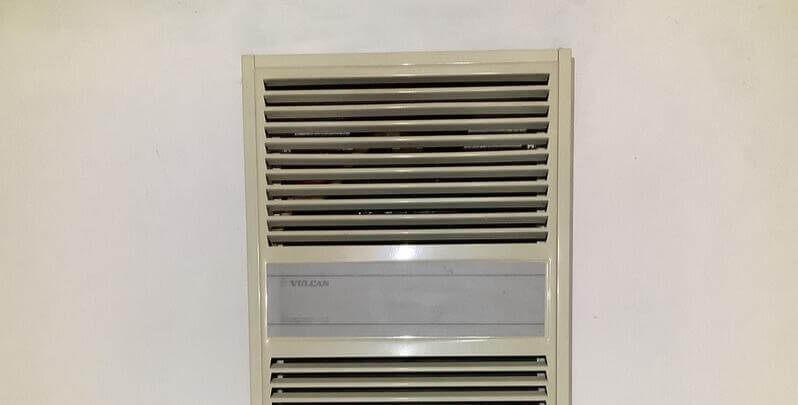What is a Wall Furnace?

A wall furnace is a popular heating solution for many Australian homes, providing efficient and effective warmth during the colder months. Unlike traditional central heating systems, wall furnaces are installed directly into the wall, making them a space-saving option that fits seamlessly into various home layouts.
Let’s explore the question of “what is a wall furnace?”, as well as how it works, and its benefits for home heating. We will also explore the different types of wall furnaces available, discuss installation and maintenance considerations, and provide essential safety tips to ensure you get the most out of your heating system.
Wall Furnaces: What Do They Do?
A wall furnace is a type of heating appliance installed within or attached to a wall, designed to heat a specific area or room in a home. It comprises:
- a heating unit
- a fan or blower to distribute heated air, and
- a vent to expel exhaust gases like carbon monoxide
Depending on the model, you can have either an electric or gas wall furnace in your home.
The Difference Between Wall Heaters and Ducted Heating
Unlike ducted heating systems that distribute heat throughout a whole house via a ducting system, wall furnaces are focused on heating a single space. This design not only saves energy but also reduces heating costs.
Wall furnaces are particularly beneficial for homes with limited space, as they are compact and unobtrusive. They are ideal for use in bedrooms, living rooms, or any other living areas in the home that need immediate, reliable heat.
How Does a Wall Furnace Work?
A wall furnace works by drawing in cool air from the room, heating it, and then redistributing the warmed air back into the space. The process begins with the ignition of a gas or electric heating element inside the furnace. For gas models, this involves a burner igniting the gas, while electric models use a heating coil.
A fan or blower circulates the heated air throughout the room. This ensures even heat distribution, maintaining a comfortable temperature. The warmed air is expelled through vents located at the front of the unit, while exhaust gases from gas models are safely vented outside through a flue.
Modern wall furnaces often come equipped with thermostats and advanced control systems that allow users to set and maintain their desired temperature. Some models also feature safety shut-off mechanisms to prevent overheating and ensure safe operation.

Benefits of Using a Wall Furnace
Like many space heaters, wall furnaces offer several benefits that make them a perfect solution for home heating. They include:
- Energy efficiency – by focusing on heating one room or two rooms, rather than an entire home, wall heaters can significantly reduce energy consumption and lower utility bills.
- Cost-effectiveness – wall furnaces are typically less expensive to install compared to a ducted heating system. They also provide economical heating.
- Space-saving design – the compact and unobtrusive design is particularly advantageous for homes with limited space.
- Quick and reliable heating – an ultra efficient furnace is ideal for keeping your home comfortable during colder months.
A licensed air conditioning technician can help you get the most out of your new or existing wall furnaces so you can enjoy these benefits to the fullest.
Types of Wall Furnaces
Wall furnaces come in two main types: a gas wall furnace and an electric equivalent. Each has its own set of advantages and considerations, making it essential to choose the right one for your specific needs and circumstances.
The Gas Wall Furnace
A gas wall furnace is powered by either natural gas or LPG. These units are known for their high efficiency and relatively low operating costs. Gas wall heaters heat up quickly and can provide consistent warmth.
One of the main benefits of gas wall heaters is their cost-effectiveness. Natural gas is often cheaper than electricity, which generally means lower ongoing energy bills. They also typically have higher heating capacities, making them suitable for larger rooms that require substantial heating.
However, gas wall furnaces require a connection to a gas line, which can limit their placement options within the home. Proper ventilation is also essential to safely expel exhaust gases such as carbon monoxide.
Electric Wall Furnaces
An electric-powered wall heater is often easier to install than a gas wall heater. It does not require a gas line or flue for venting, which can simplify installation and placement within the home.
The primary advantage of an electric wall heater is its convenience. They offer precise temperature control and can be installed in various locations without the need for extensive modifications. Electric furnaces are also generally quieter than gas models, providing a more peaceful heating solution.
Is Electric Cost Effective Though?
However, electric wall furnaces can be more expensive to operate due to higher electricity costs. They may also have lower heating capacities compared to gas units, making them better suited for smaller rooms or areas where supplemental heating is needed.
Choosing between a gas and an electric wall heater depends on your heating needs, installation preferences, and budget. Both types offer reliable heating solutions with unique benefits that can cater to different home environments.
The Importance of Wall Furnace Maintenance
Regular maintenance is crucial to ensure the efficient and safe operation of your wall furnace. Routine tasks include:
- cleaning the unit
- inspecting the components, and
- replacing filters as needed
Keeping the furnace clean helps maintain optimal airflow and prevents the build-up of dust and debris.
We recommend having a licensed specialist service your wall heater annually to check for any potential issues and to perform necessary adjustments. This includes:
- inspecting the heat exchanger
- checking for gas leaks (for gas models), and
- making sure all electrical connections are secure
Regular servicing not only enhances performance but also extends the lifespan of your wall furnace.

Consider Installing a Wall Furnace in Your Home
Wall furnaces offer an efficient and cost-effective heating solution, with the added benefits of space-saving design and quick heat delivery. Understanding the different types, maintenance requirements, and safety considerations can help you make an informed decision about incorporating a wall furnace into your home.
When considering a wall furnace, always seek professional advice for installation and maintenance to ensure optimal performance and safety. With the right care, a wall furnace can provide reliable and efficient heating for many years, keeping your home warm and comfortable during the colder months.
Please note: Thank you for reading our blog “What Is A Wall Furnace?”. This information is provided for advice purposes only. Regulations differ from state to state, so please consult your local authorities or an industry professional before proceeding with any work. See After Hours Air Conditioning’s Terms & Conditions here.